- Marketing management integrates planning, execution, analytics, and leadership to drive customer value and business growth across industries.
- Core frameworks like STP, the 4Ps/7Ps, and Porter’s strategies structure go-to-market plans, positioning, and channel optimization.
- AI, personalization, and omnichannel ecosystems are transforming marketing into a data-driven, customer-centric discipline at global scale.
Marketing management isn’t about campaigns or ad budgets. It’s about orchestrating the entire process by which a business defines, communicates, and delivers value to its market. It’s the intersection of strategy, customer psychology, data, creativity, and operations. Done right, it not only drives growth but also builds lasting brands and relationships.
In my work with marketing teams across sectors, I’ve seen the difference between organizations that treat marketing as a tactical function and those that embed it at the heart of decision-making. The latter are the ones consistently outperforming their competitors. This article pulls together the foundational frameworks, strategic tools, evolving trends, and practical insights I rely on in my own practice. Think of it as a masterclass in what marketing management truly entails.
Core Principles and Functions of Marketing Management
Let’s start with the essentials. Every marketing organization, no matter how complex or nimble, is grounded in five interconnected functions: planning, organizing, leading (or directing), controlling, and evaluating. These are the levers through which marketing managers turn strategy into results.

Planning: Defining Direction with Intent
Strategic planning is where all good marketing begins. It’s the process of identifying which markets to serve, what problems to solve, and how to create a competitive advantage while aligning with broader business goals.
Planning involves:
- Conducting market research and competitor analysis
- Segmenting customers and sizing opportunities
- Setting priorities and allocating limited resources
Beyond the data, effective planning requires judgment, knowing where to focus, how to prioritize, and how to align with the company vision.
Every high-performing marketing leader I’ve worked with has one thing in common: a documented, well-communicated marketing strategy that cascades into clear objectives, timelines, and deliverables.
Organizing: Aligning Teams, Resources, and Capabilities
Once the strategy is defined, organizing ensures it’s executable. This is where team structures, budgets, workflows, and technology stacks come into play. It also involves defining roles and responsibilities, which is especially important in modern marketing where brand, performance, product marketing, and content often operate in parallel.
Common organizing activities include:
- Structuring teams for accountability and collaboration
- Aligning budgets and technology to strategic priorities
- Integrating external partners such as media agencies, research firms, and MarTech vendors
As a consultant, I often walk into companies where everyone’s “busy” but no one’s aligned. That’s usually a sign of poor organization. Without clear ownership and accountability, even the best strategy falls flat.
Directing: Leading the Marketing Engine
Leadership in marketing is equal parts inspiration and execution. It means guiding teams, motivating creatives, and aligning stakeholders. More than that, it’s about being the steward of the customer within the organization.
Marketing leaders must:
- Navigate cross-functional dependencies with product, sales, customer success, and finance
- Encourage creativity while maintaining strategic alignment
- Stay agile and adjust direction when campaigns underperform
I always tell new CMOs: you’re not just leading a department; you’re managing change, culture, and customer perception at the same time.
Controlling: Monitoring What Matters
Controlling is about visibility and discipline. It’s the process of setting KPIs, tracking progress, and intervening when needed. Every campaign, initiative, and channel should be tied to measurable objectives such as MQLs, conversion rate, CAC, NPS, or revenue impact.
Control mechanisms should include:
- Clear KPIs and performance dashboards
- Regular review cadences and escalation paths
- Processes for reallocating resources when results lag
But control isn’t just about reports. It’s about having the courage to pause a failing initiative, change messaging midstream, or redirect spend to what’s working. Good marketers optimize constantly. Great ones know what not to chase.
Evaluating: Learning and Looping Forward
Too many teams finish a campaign and immediately move on to the next. That’s a mistake. Evaluation closes the loop between effort and outcome; it’s where learning happens.
Key evaluation practices include:
- Post-mortems and performance debriefs
- Customer feedback loops and win/loss analysis
- Competitive reviews and insight tracking
Asking what worked, what didn’t, and why transforms marketing execution into strategic learning. Over time, systematic evaluation creates a culture of continuous improvement. The best teams treat every initiative as an experiment that yields insights, regardless of performance.
Strategic Frameworks and Tools in Marketing Management
Effective marketing isn’t guesswork. It’s structured around proven strategic models and tools that help us make sense of market complexity, align internal resources, and deliver consistent customer value. These are the instruments I rely on when advising clients, especially during market entry, brand repositioning, or performance turnarounds.

Segmentation, Targeting, and Positioning (STP)
If I had to choose one model every marketer must master, it’s STP. It’s not just a strategic framework; it’s the backbone of relevance. First introduced by Philip Kotler in 1969, the STP model changed the way we approach marketing strategy by shifting focus from product-centric to customer-centric planning.
Segmentation: Finding Meaningful Difference
Markets are not homogeneous. Customers differ in demographics, behavior, psychographics, and preferences. Segmentation is about identifying those differences in a structured way so we can treat groups differently.
In practice, I look at segmentation on two levels:
- Macro-segmentation: Markets divided by geography, industry, or vertical.
- Micro-segmentation: Focus on user needs, buying behavior, usage intensity, or attitudes.
We often use clustering techniques or decision trees to analyze large customer datasets, but qualitative insight (like voice-of-customer interviews) is just as crucial.
Targeting: Allocating Resources Strategically
Once you know the segments, you decide where to compete; targeting is a strategic decision, not just a tactical one. It answers the question: which customers are most valuable and winnable?
I guide clients to score segments based on:
- Size and growth potential
- Competitive intensity
- Profitability
- Strategic fit
For early-stage companies, targeting one or two niche segments can create focus and faster traction. For mature firms, a multi-segment strategy or differentiated positioning per segment may be appropriate.
Positioning: Owning a Space in the Customer’s Mind
Positioning is where marketing comes to life. It’s how you frame your value in a way that’s credible, meaningful, and distinct. You don’t get to decide your positioning, your customers do. But you do control the messaging and experience that shape it.
The best positioning statements are sharp, specific, and grounded in customer truth. Here’s a simple structure I often use:
“For [target segment], [Brand] is the [frame of reference] that [point of difference] because [reason to believe].”
For example:
“For early-stage SaaS startups, we’re the only marketing partner that delivers GTM strategy with hands-on execution, because we’ve scaled three of our own ventures.”
That kind of clarity builds internal alignment and external resonance.
The Marketing Mix: 4Ps and Beyond
The 4Ps Product, Price, Place, Promotion have stood the test of time. They help ensure that strategy translates into execution across the entire customer journey.
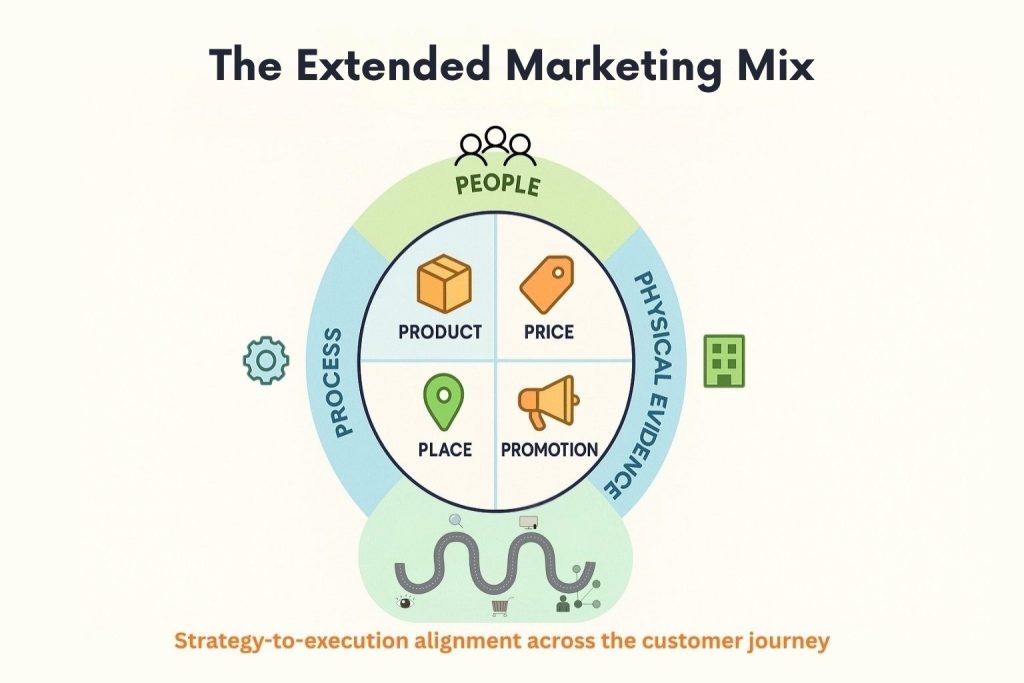
Product
This is your value proposition made tangible. It includes features, benefits, design, packaging, and lifecycle management. Great marketing managers work closely with product and R&D to make sure what’s built matches what customers need.
In B2B, this often means shaping the roadmap based on customer feedback and competitor benchmarks. In B2C, it might mean seasonal variations or bundling strategies to drive purchase intent.
Price
Pricing is both art and science. It signals quality, determines margins, and drives positioning. I’ve run pricing strategy sessions where we used conjoint analysis and elasticity modeling, but even then, qualitative insight is essential.
Whether you pursue cost-based, value-based, or competitive pricing, it must align with your brand promise. A premium brand can’t afford inconsistent discounting.
Place
Place is about distribution, getting the product into the hands of customers, at the right time and in the right format. For some brands, it’s about shelf space and retail partnerships. For others, it’s about optimizing digital channels, marketplaces, or DTC logistics.
We often map out the customer’s buying journey and ensure every channel touchpoint supports both brand and conversion goals.
Promotion
Promotion is the communication layer, including advertising, PR, sales promotions, content, influencer marketing, and more. It’s not about shouting louder. It’s about being relevant and timely.
In my work, we often design integrated campaigns that connect awareness, consideration, and conversion touchpoints. This might look like a targeted LinkedIn campaign that leads to a gated white paper, followed by a retargeted webinar invitation and a tailored sales pitch.
Extended 7Ps for Services
In services or high-touch experiences, we add:
- People: Frontline staff, culture, and training
- Process: The service delivery mechanism
- Physical Evidence: Tangible cues that convey quality (design, office layout, digital UX)
I’ve worked with consulting firms and luxury brands where the physical environment and team behavior were more impactful than any paid media.
Digital Channels and MarTech
Digital has transformed not just how we promote, but how we plan, measure, and evolve marketing.
Owned, Earned, and Paid Media
A solid digital strategy includes:
- Owned media: Websites, blogs, email, CRM
- Earned media: Social shares, PR, backlinks
- Paid media: Search ads, social ads, display, sponsorships
I advise clients to use a channel mix based on the funnel stage. For instance, SEO and PR are great for awareness, email nurtures leads, and paid retargeting closes deals.
The Martech Stack
The average mid-market firm uses 20+ marketing tools across categories like:
- CRM (HubSpot, Salesforce)
- Automation (Marketo, ActiveCampaign)
- Analytics (Google Analytics, Mixpanel)
- Content Management (WordPress, Webflow)
- Social Media Management (Sprout, Buffer)
What matters is integration. Tools don’t solve problems; strategies do. But without the right stack, scale becomes impossible.
Marketing Analytics and Data-Driven Management
If you’re not measuring, you’re not managing.
I always push teams to define their north star metrics: the one or two KPIs that best indicate long-term success. In SaaS, this might be the net retention rate. In eCommerce, it could be a customer lifetime value.
Performance Metrics
Here are some of the metrics we commonly track:
- Traffic and conversion rates
- CAC, LTV, and payback period
- Email open/click rates
- Social engagement and sentiment
- Funnel conversion by stage
Attribution and Optimization
Attribution remains tricky, especially in multi-touch journeys. But with UTM parameters, marketing automation, and tools like Triple Whale or Dreamdata, we can now get much closer to true ROI.
I recommend regular testing: A/B, multivariate, and lift tests. I don’t care how creative a campaign is if it’s not tested and optimized; it’s guesswork.
Academic Foundations of Marketing Strategy
To build systems that scale and campaigns that endure, you need more than practical know-how. You need theory. The best frameworks in marketing don’t just sit in textbooks; they underpin real-world decisions. Below are the ones I keep returning to when coaching senior teams or designing curriculum for marketing leadership development.
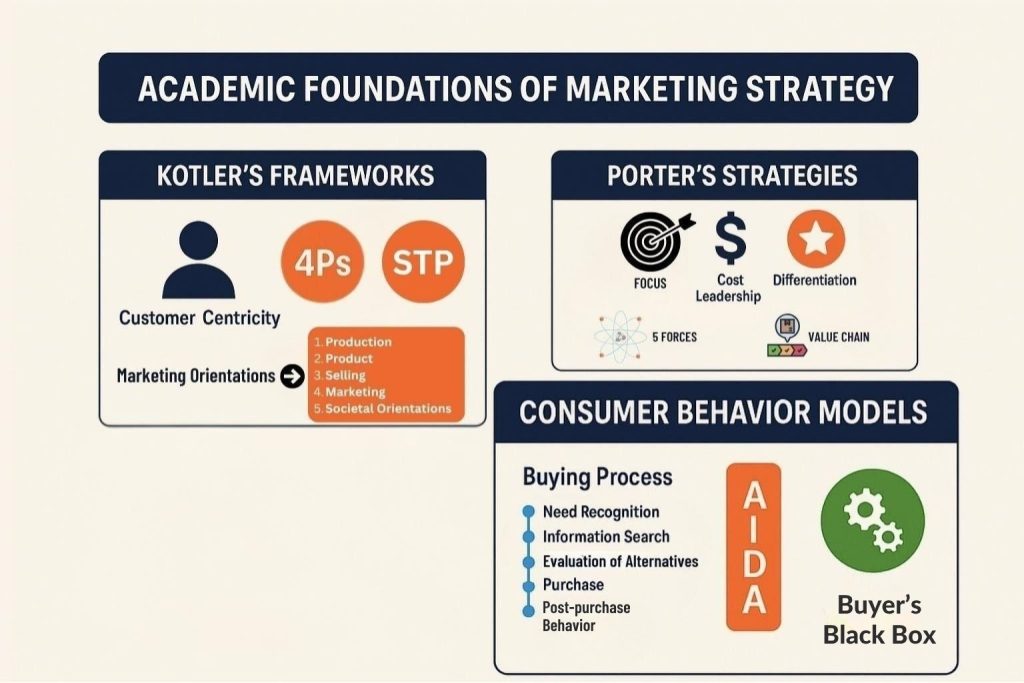
Kotler’s Customer-Centric Frameworks
Philip Kotler isn’t just the father of modern marketing; he’s the architect of customer orientation as a strategic discipline.
The Marketing Concept
Kotler’s core idea is simple but revolutionary: organizations succeed not by selling what they make, but by understanding and satisfying customer needs better than competitors. This flipped the traditional product-first mindset and made customer value the north star.
In practice, I advise teams to start every strategic planning session with a simple prompt: “What is the core customer problem we are solving, and why are we the best suited to solve it?”
STP and the Marketing Mix
Kotler popularized STP and 4Ps as execution tools for the marketing concept. They aren’t standalone tactics; they serve as scaffolding. If your segmentation doesn’t reflect real behavioral or attitudinal differences, your positioning will be weak. If your product mix isn’t built around that positioning, you’re wasting resources.
I treat STP and 4Ps as checklists during campaign planning. They force discipline and clarity.
Marketing Orientations
Kotler also outlined five stages of marketing evolution:
- Production orientation: Focus on efficiency and availability.
- Product orientation: Focus on features and quality.
- Selling orientation: Focus on persuasion.
- Marketing orientation: Focus on customer needs.
- Societal marketing: Focus on customer and societal welfare.
Most companies today aim for stage 4, but I increasingly advise clients to integrate stage 5. Sustainability, equity, and transparency aren’t fluff; they’re part of brand value now.
Porter’s Competitive Strategies
Michael Porter’s frameworks are usually taught in MBA strategy courses, but they’re essential for marketing managers, too. If you don’t understand how your company competes, you won’t market your products or services effectively.
The Three Generic Strategies
- Cost Leadership: Be the lowest-cost producer. Appeal to price-sensitive segments.
- Differentiation: Offer unique value. Build a brand that commands premium pricing.
- Focus: Serve a narrow market better than anyone else.
Each implies very different marketing choices. A cost leader invests in reach and simplicity. A differentiator emphasizes brand storytelling, UX, and customer service. A focused strategy often involves vertical-specific messaging, referral programs, or community building.
When clients struggle with messaging, it’s often because their business strategy is unclear or contradictory. Marketing can’t solve what strategy hasn’t been clarified.
Five Forces and Value Chain
Porter’s Five Forces model helps marketers understand the external pressures of competitors, suppliers, buyers, new entrants, and substitutes. The Value Chain helps identify internal differentiators. Both are useful during competitive audits or when repositioning a brand in a crowded space.
Consumer Behavior Models
If you’re not grounded in how people make decisions, your campaigns will miss the mark. I always train marketing teams to think in terms of customer psychology, not just metrics.
The Five-Stage Buying Process
- Problem Recognition
- Information Search
- Evaluation of Alternatives
- Purchase Decision
- Post-Purchase Evaluation
Every content and touchpoint should map to one of these stages. For example, TOFU (top-of-funnel) content supports information search. Mid-funnel assets (like comparison guides) help with evaluation. Post-purchase email sequences reinforce satisfaction and reduce churn.
AIDA Model
A classic, but still useful: Attention, Interest, Desire, Action. Especially in advertising and direct response, this helps shape the narrative arc. Hook, engage, convince, convert.
Buyer Black Box
Kotler’s “black box” model reminds us that we don’t always see what’s inside the customer’s head. But we can influence through stimuli (product, price, promotion), and interpret the response (purchase, no action, advocacy). It’s a reminder to observe behavior more than self-reported preferences.
Real-World Applications by Industry
Theory is important, but context is everything. Marketing strategies don’t look the same in retail as they do in SaaS, or in hospitals. Over the past 15 years, I’ve worked across sectors, and I can tell you: industry context shapes everything from team structure to messaging tone.
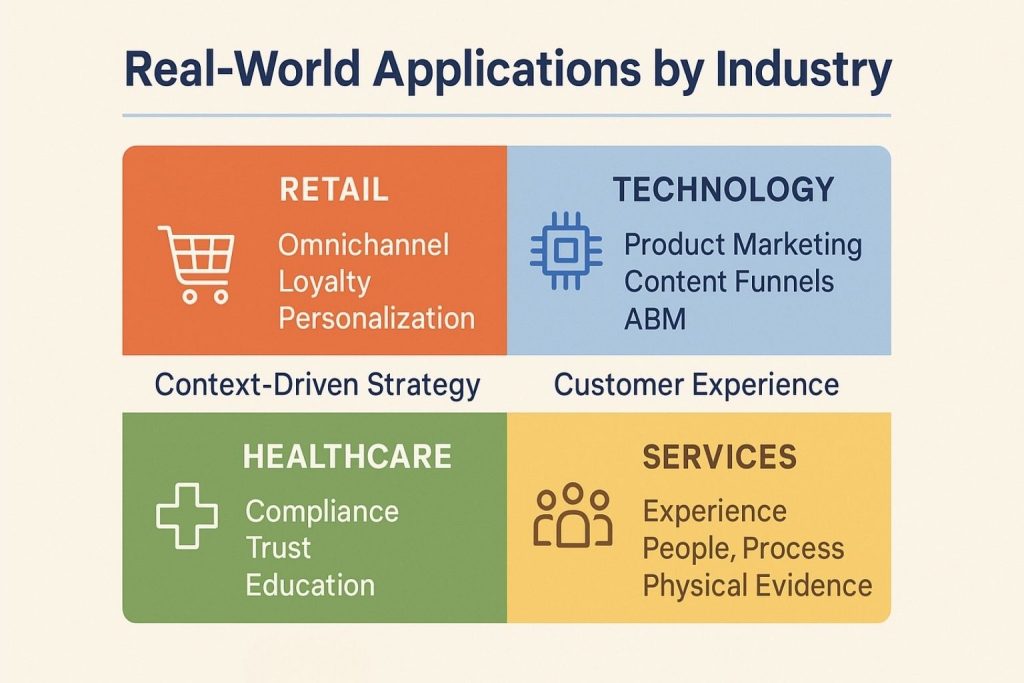
Retail
Retail is a war of execution. Brands win by being present, relevant, and responsive. Whether online or offline, the customer experience is the brand.
Tactics that Matter
- Omnichannel Integration: Sync in-store, online, mobile, and call center experiences.
- Loyalty Programs: Drive retention and data collection.
- Visual Merchandising: Especially in brick-and-mortar, how you present is how you sell.
- Flash Promotions: Timed urgency often beats brand equity in short bursts.
Metrics to Track
- Conversion rate per channel
- Average order value
- Cart abandonment rate
- Repeat purchase rate
- Channel-specific ROI
Retailers that master personalization, like Sephora, Target, or ASOS, build a massive advantage through CRM-driven recommendations and behavioral targeting.
Technology
In tech, marketing is education. The buyer often doesn’t fully understand the solution until you explain it clearly, credibly, and repeatedly.
Key Strategies
- Product Marketing: Bridge engineering and sales. Own positioning, launches, and messaging.
- Content-Led Funnels: Whitepapers, webinars, case studies, explainer videos.
- Community Building: Developer relations, open-source evangelism, Discords, and Slack groups.
- Account-Based Marketing (ABM): High-impact, personalized campaigns for key accounts.
Typical Challenges
- Long sales cycles
- Complex value propositions
- Competing with legacy systems
- Navigating gatekeepers (procurement, IT)
I advise every tech client to align tightly with product and sales. Without that triangle, marketing becomes decoration.
Healthcare
Healthcare marketing operates under a microscope. It’s emotional, ethical, and regulated.
What Sets It Apart
- Regulatory Compliance: FDA, HIPAA, and country-specific laws.
- Multiple Audiences: Patients, providers, payers, and regulators.
- Trust as Currency: Without trust, no message works.
- Wellness and Education: Marketing often overlaps with public health and content.
Effective Channels
- SEO and patient-focused blogs
- Physician referral networks
- Health outcomes data storytelling
- Local community engagement
Tone is everything. Compassion beats cleverness. Accuracy beats persuasion. We don’t “sell” healthcare, we guide decisions.
Services
Services are intangible. What we’re really marketing is experience, expertise, and outcomes. That means brand perception and client relationships matter more than product specs.
What Works
- Case Studies and Testimonials: Show the impact, not just the features.
- Process Clarity: Map the customer journey and communicate expectations.
- People Branding: In consulting, law, or finance, your people are your brand.
- Referral Programs: Especially effective in high-trust industries.
Service-Specific Ps
- People: Staff behavior, training, attitude
- Process: Frictionless onboarding, SLAs, response times
- Physical Evidence: Offices, decks, dashboards, customer portals
In professional services, marketing is often indistinguishable from operations. That’s not a bug; it’s a competitive advantage if managed well.
Emerging Trends and Innovations in Marketing Management
Marketing has always evolved in tandem with technology and culture; however, the past five years have accelerated this pace. What used to change every decade now changes every quarter. The most effective marketing managers aren’t just keeping up, they’re designing systems that anticipate change. Let’s unpack the major forces shaping the next era of marketing.
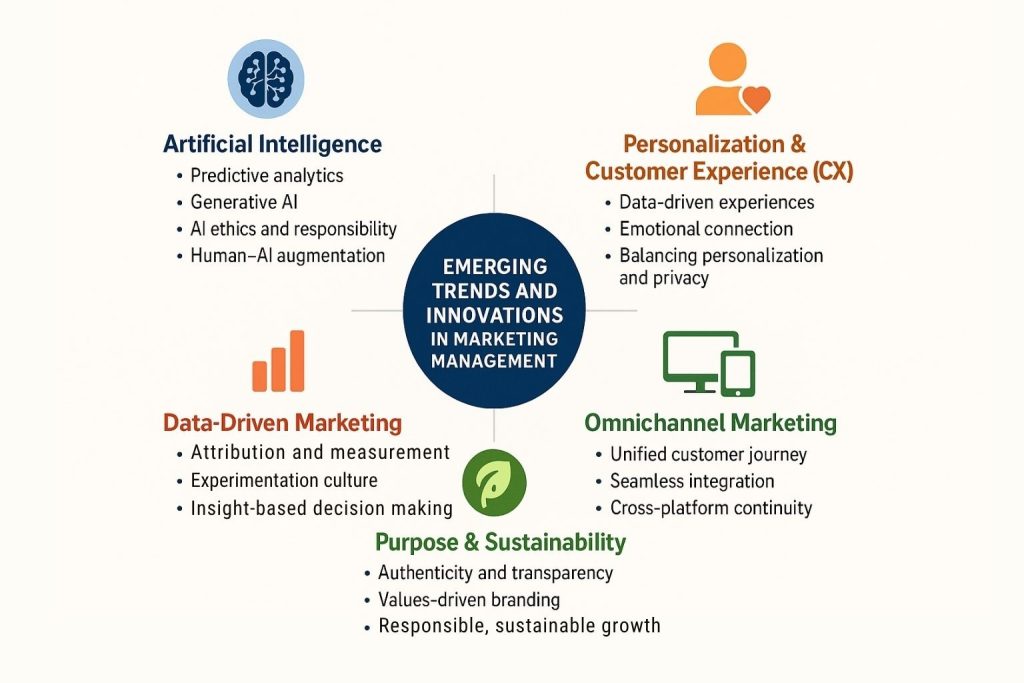
Artificial Intelligence: From Automation to Augmentation
AI isn’t a distant trend. It’s already woven into nearly every aspect of modern marketing. From predictive analytics to generative content creation, it’s transforming how teams plan, execute, and optimize campaigns. As artificial intelligence continues to influence how brands are discovered online, understanding how AI shapes search and visibility has become crucial for marketers seeking to stay ahead of the digital evolution.
Predictive Intelligence and Analytics
We’ve moved past simple dashboards. AI-driven analytics platforms can now forecast campaign outcomes, segment audiences dynamically, and detect anomalies in performance. For example, predictive lead scoring models can identify which prospects are most likely to convert based on behavioral data, helping sales teams prioritize high-quality leads without guesswork.
Generative AI in Content and Creative
Generative AI tools have revolutionized creative production. From drafting copy and designing visuals to producing video variations, they cut production time dramatically. However, I use them cautiously. AI should augment human creativity, not replace it. The best outcomes come when strategists define the intent and editors fine-tune the result. The human layer remains irreplaceable for emotional nuance and brand consistency.
Personalization and the Rise of Customer Experience
Personalization has evolved far beyond “Hi [Name]” in an email. We now tailor entire experiences to what customers see, when they see it, and through which channel.
Data-Driven Personalization
With advanced CRMs and CDPs (Customer Data Platforms), we can create unified profiles that reflect a customer’s history, preferences, and intent. This allows marketers to deliver truly contextual interactions, like showing a returning visitor a different website homepage than a first-time visitor, or sending replenishment reminders for consumable products.
But personalization isn’t just technical, it’s emotional. Customers expect to feel seen and understood. A brand that consistently delivers that experience earns loyalty that no discount can buy.
Balancing Relevance with Privacy
Privacy laws like GDPR, CCPA, and the end of third-party cookies are reshaping how we personalize. The shift toward first-party data is forcing marketers to rebuild trust through transparency and value exchange. “Tell us about yourself, and we’ll make your experience better.”
As I tell my clients: Respect for privacy is the new personalization currency.
Data-Driven Marketing and Measurement Innovation
The modern marketer’s power comes from data literacy. But data without interpretation is noise. True data-driven management means knowing what to measure, why it matters, and when to act.
Attribution and the Multi-Touch Reality
Customers rarely buy after one click. They discover, compare, and return across multiple channels. Advanced attribution models like data-driven or algorithmic attribution help assign fair credit across the journey.
However, attribution should inform, not dictate. I remind teams: a metric is only as valuable as the decision it enables.
Experimentation as Culture
The best marketing organizations treat campaigns as ongoing experiments. They run A/B tests weekly, not annually. They measure lift, learn fast, and roll out what works. This culture of experimentation demands humility, acknowledging that even expert instincts can be wrong, and only data tells the truth.
Omnichannel Marketing: The Unified Customer Journey
Omnichannel isn’t just about being present everywhere; it’s about being consistent everywhere. A customer might start with a YouTube ad, visit your site, chat with support, and finally purchase via mobile. To them, it’s one continuous brand experience. To us, it’s a complex orchestration challenge.
Integration and Continuity
Modern CRM systems and marketing automation tools now allow real-time data sync across touchpoints. This means if a user abandons a cart on desktop, the system can automatically trigger a personalized mobile push notification later. That’s what true omnichannel integration looks like.
Metrics that Matter
Instead of channel-specific KPIs, I look at journey metrics: customer effort score, cross-device conversion rate, and time-to-repeat purchase. These give a more accurate view of customer experience across the entire journey.
Omnichannel strategies also require tight collaboration between marketing, sales, and operations. The silos that once defined departments are becoming liabilities. Alignment is the new advantage.
The Rise of Purpose and Sustainability in Marketing
Values now stand alongside price and quality as key purchase drivers. Customers, especially younger generations, are drawn to brands that reflect their ethics and contribute meaningfully to society. This has made sustainability not just a communications theme but a strategic pillar of long-term brand growth.
Purpose as Strategy
True purpose-driven marketing goes beyond surface-level messaging. It involves integrating ethical sourcing, transparent communication, and responsible storytelling into every stage of the brand journey. For many organizations, this shift requires strategic leadership that can balance profitability with social responsibility, the kind of guidance that helps marketing evolve into a catalyst for sustainable business growth.
Global Perspective in Marketing Management
Managing marketing across borders isn’t a simple matter of translation or replication. It’s a complex orchestration of global strategy and local nuance. I’ve worked with brands expanding into EMEA, LATAM, and APAC, and each move presents both opportunities and challenges. Marketing at a global scale demands cultural fluency, operational coordination, and strategic patience.
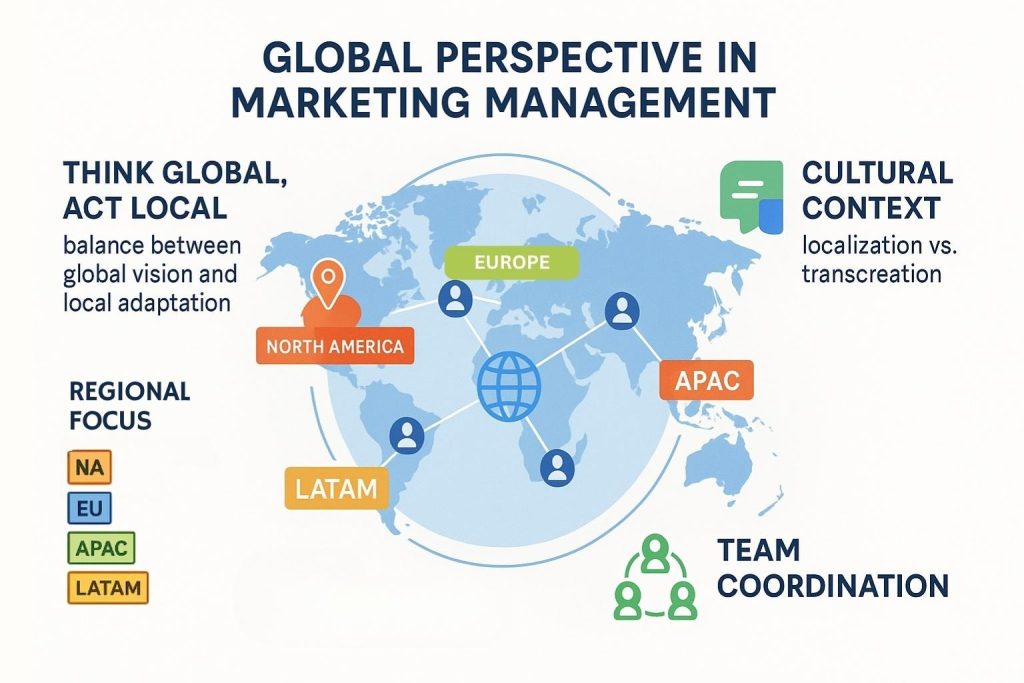
Think Global, Act Local: The Glocal Imperative
Most marketers are familiar with the phrase “think globally, act locally,” but few know how to operationalize it. Successful global brands achieve strategic coherence at the top level, while enabling tactical flexibility at the market level.
Centralized vs. Localized Models
You have three primary models to consider:
- Centralized Strategy and Execution
Efficient but rigid. Works best when brand equity is already global and offerings are commoditized (e.g., SaaS tools, B2B services). - Central Strategy with Local Execution
My preferred model. Global HQ defines brand narrative, positioning, and high-level campaigns. Local teams adapt creative channels and messaging to resonate with cultural norms. - Fully Decentralized (Multinational) Strategy
High flexibility, high risk. Each market operates independently. It can dilute the brand and create duplication. Suitable only for extremely diverse markets or where brand equity is local by nature.
Most organizations benefit from a hub-and-spoke model: global brand governance with empowered local marketing leads.
Cultural Context and Consumer Behavior
Culture impacts everything from color psychology and humor to decision-making and risk aversion. I’ve seen brands fail spectacularly because they assumed consumer logic was universal. It’s not.
Localization vs. Transcreation
- Localization: Translating content and adapting visuals or formats for local markets.
- Transcreation: Rewriting core messaging to resonate emotionally with local values and idioms.
For instance, a tagline that relies on irony in the U.S. may fall flat in Japan or the Middle East. When we helped a client launch in Brazil, we rewrote their entire value proposition in Portuguese, not because of language barriers, but because the underlying cultural motivators were different. In the U.S., it was about efficiency. In Brazil, it was about trust and community.
Global Campaign Pitfalls
- Humor that doesn’t translate
- Colors with negative associations
- Religious or political missteps
- Product features are irrelevant in local use cases
- Media usage habits that don’t align with the channel strategy
Every global launch needs a cultural audit. No exceptions.
Regional Strategy Examples
Here’s a brief overview of how marketing strategy shifts by region:
- North America: Performance marketing, influencer marketing, direct response, and loyalty programs are well-developed. Consumers expect convenience and speed.
- Europe: More privacy-conscious and skeptical of overt personalization. Higher preference for brand storytelling, long-term trust, and high-quality production value.
- Asia-Pacific: Mobile-first, socially driven, and often collectivist in behavior. Platforms like WeChat, LINE, and Shopee dominate in ways Western teams may not anticipate.
- Middle East & Africa: Growing digital adoption but still reliant on traditional media in some regions. Cultural and religious considerations are critical.
- Latin America: Strong social engagement, price sensitivity, and importance of word-of-mouth. WhatsApp often plays a bigger role than email.
Understanding not just what channels to use, but how people emotionally respond to messaging in each region, is where global marketing becomes truly effective.
Managing a Global Marketing Team
When I consult for organizations scaling internationally, we often restructure marketing into pods aligned by region, each led by someone with both marketing expertise and cultural fluency. These pods feed back into a central brand strategy team.
Key practices for success:
- Global playbooks with local execution guidelines
- Regular cross-regional syncs to share what’s working
- Shared KPIs but localized benchmarks
- Real-time translation workflows for creative assets
- CRM and Martech stack integration across regions
Operationally, a strong global marketing org acts like a jazz band, each region improvising within the framework, not an orchestra reading the same sheet music.
To Conclude: Marketing Management as a Strategic Catalyst
Marketing management isn’t a support function. It’s the strategic catalyst that shapes how a company grows, competes, and sustains relevance in the marketplace. It bridges the business with the customer. It fuses creative ideas with operational discipline. And it adapts to culture, technology, and data in real time.
We’ve covered a lot of ground, foundational principles, executional tools, theoretical frameworks, real-world applications, emerging innovations, and the global landscape. But if there’s one thing I’d leave you with, it’s this:
Marketing management is the art of delivering value at scale, value that customers recognize, competitors can’t replicate, and organizations can grow around.
That requires cross-functional leadership, strategic clarity, relentless measurement, and human empathy. It’s not easy work. But done right, it drives everything else.
As someone who’s spent a career in the field, I don’t see marketing as a department. I see it as the heartbeat of modern business. And we, as marketing leaders, are the ones who keep it beating strong.

How RiseOpp Helps You Execute Marketing Management That Scales
At RiseOpp, we live and breathe marketing management not just in theory, but in the trenches alongside our clients. Everything discussed in this article, from developing a unified go-to-market strategy to building omnichannel systems to navigating global brand expansion, is what we do daily through our Fractional CMO services and SEO leadership engagements.
Our clients come to us when they need strategic clarity and expert execution. Whether they’re scaling a SaaS product, repositioning an eCommerce brand, or entering new markets, we help bridge the gap between high-level marketing vision and real-world results.
When it comes to SEO, we bring a competitive edge through our proprietary Heavy SEO methodology, a system designed to drive long-term organic growth by ranking your business for tens of thousands of relevant keywords. And through our Fractional CMO engagements, we advise on everything from brand messaging and team structure to channel mix and paid media optimization across Google, Meta, LinkedIn, TikTok, email, affiliate marketing, and beyond.
In short, we don’t just talk about marketing management; we build the systems, hire the talent, and implement the frameworks that make it work.
If you’re serious about taking your marketing to the next level, let’s talk. Whether you’re a growth-stage B2B company or a consumer-facing brand looking to scale, RiseOpp can step in as your strategic partner and fractional CMO team to drive the results you need.
Comments are closed